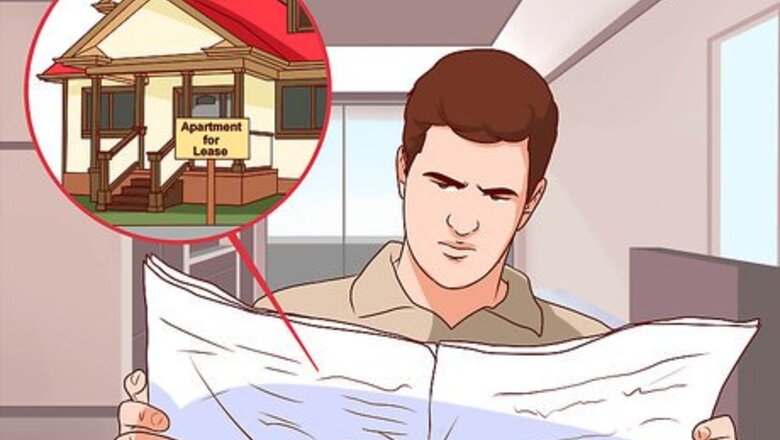
views
Using Online Resources
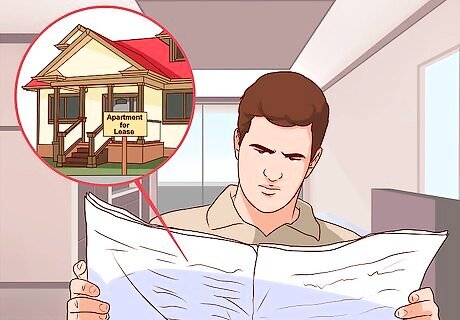
Check your community newspaper. Most local papers have sections in print or online dedicated to community bulletins, advertisements, and classified listings. Landlords and building managers often use these when they have units or suites available for rent. Copies of local newspapers are usually available to browse through for free in libraries.

Have a look at online classified sites. Along with local community classified listings, there are also international classifieds online that can be customized to specific cities. Many landlords use these to advertise available rental suites and apartments, and you can often narrow your search based on distance, price, and availability. Classified listing sites to check include: Craigslist Kijiji and eBay Classifieds Oodle PennySaver Classified Ads Gumtree Recycler Adoos Hoobly

Use an apartment-search website. There are lots of websites and tools dedicated to helping people find apartments. These will either be independent sites where landlords advertise vacancies or web tools that combine listings from different sources. Good sites to check include: MyApartmentMap Apartments.com Hotpads Padmapper ForRent.com Rent Jungle MyNewPlace
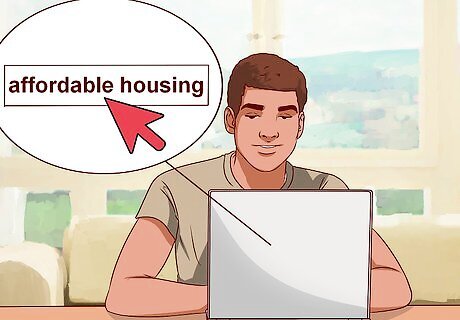
Look at special websites for affordable housing. There are plenty of community and government websites that can help you find affordable housing if you need or are receiving financial assistance. The websites will vary based on country and region, but there are some simple search terms you can use to find what you're looking for: Try searching terms like “affordable housing” plus the region where you're looking Look at social services websites Search for “low-income housing” in your area
Looking in the Community
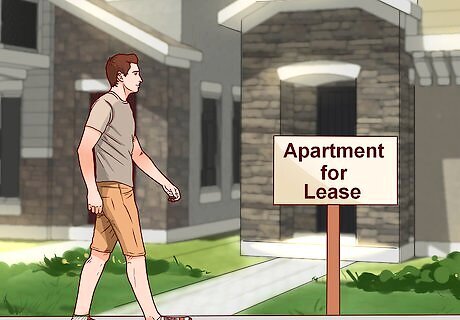
Walk around the neighborhood. One of the best ways to find apartment vacancies is to walk around looking for signs in windows that advertise availabilities. You may find vacancies that aren't listed on any electronic database or website. Look for signs that say “vacancy,” “to let,” “for lease,” or “for rent.” Look at both ground-level and upper-story windows, because you may find available units located above stores. Many apartment buildings advertise vacancies through signs in front or on top of the building, so be sure to walk through residential areas.
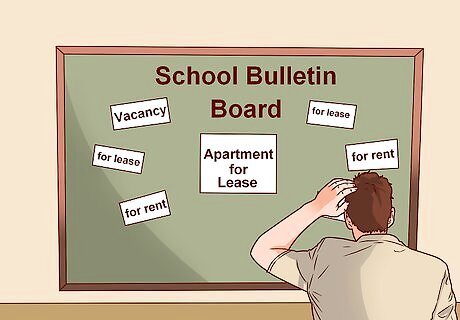
Check school bulletin boards. Some landlords will advertise rentals to students, so high school and college bulletin boards are a great place to look. Bulletin boards are often located at the entrance to the campus, near a student-housing office, in a community center, or by the front entrance of the main building.
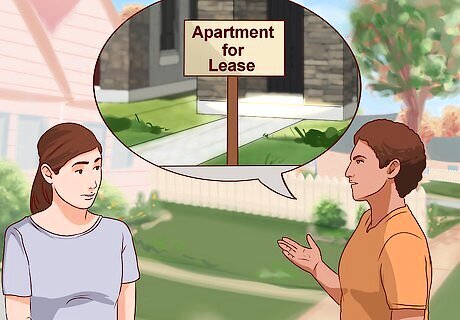
Ask friends and family. People you know who are already renting apartments are a great resource, because they already have a connection at a rental location. Ask everyone you know who currently rents an apartment to inquire with the landlord, superintendent, or building manager if there are any vacancies in the building. Because renters typically have to give a couple months’ notice before leaving a rental, the building manager may know of upcoming vacancies even if they aren't being advertised yet. Even if there aren't any units currently available, there may be a waiting list that you can put your name on in case something comes up.
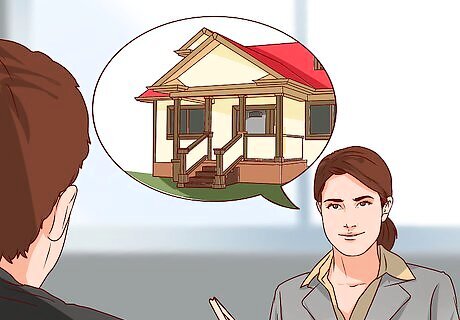
Hire a rental agent. Rental agents are common in large cities. Even a traditional real estate agency near you may deal with rentals. Such an agent could make your apartment search quick and easy. Rental agents are quite familiar with the area. If you're looking for specific amenities, a particular location, or certain features, an agent can help you find them. An agent may also have a good idea of which landlords to use and which to avoid. They may even be able to get you a better deal on the rent if they have landlords they work with frequently. Be prepared to pay a fee to an agent. It would be about 15 percent of the annual rent. Don't agree to pay the agent until you’ve actually signed the lease, and don't pay a fee higher than 15 percent.
Choosing an Apartment

Find something fitting your budget. One of the most important considerations when choosing an apartment is the cost of the rental. You shouldn’t spend more than 30 percent of your income on living costs (rent and utilities). For instance, if you make $30,000 a year or $2,500 per month, your total monthly living expenses shouldn’t exceed $750. Ask the landlord exactly what's included in the rent. When you set aside 30 percent of your income for living expenses, make sure that will cover everything, including rent, parking, and utilities such as heat and power. Some landlords require a security or damage deposit from renters at the beginning of the rental term. Other landlords may require that you pay rent for the first and last months when you start renting. Make sure you have money set aside for this.

Know what amenities are available. Not all apartments are created equal: some buildings will have better features and amenities than others. Note that the more amenities available, the higher the price will likely be. On-site amenities you may want include: Washing facilities: if the building doesn’t have these, is there a self-service laundry nearby? Parking: if you have your own car, it’s important that the apartment have a parking spot available. Is there a place for visitors to park when you have friends and family over? If not, where is the closest public parking? Pool and fitness facilities: this is a higher-end amenity that comes with a larger price tag. Many apartments have such facilities, and the extra money you'll pay in rent could be offset by the gym membership you no longer need. Communal spaces: if community and neighbors are important to you, does the apartment you're looking at have any shared spaces where you can go to meet with other people who live in the building? Storage: most apartment buildings have storage units available, but not everybody will get a spot. You may need a building with an available storage locker if you have lots of furniture or belongings and not enough room in the apartment. Outdoor space: some apartments feature a patio, terrace, or balcony.

Pick the right location. There are lots of things to consider when choosing a neighborhood, including safety, convenience, and nearby amenities. A few things to consider include: How safe and secure is the neighborhood? You can check crime rates on local police websites or on sites like Trulia Maps. Where are the nearest amenities? For instance, are there grocery stores and shopping malls nearby? Are there restaurants and entertainment close by? If you have kids, where are the closest schools and parks? How convenient is the location? Is it close to your work or school? If you don’t have a car, where is the nearest transit stop, and how long does it take you to get to and from work? To determine how convenient the location is and where the nearby amenities are, check with Google maps. Search the address of the apartment, and use the Search Nearby feature to find the nearest restaurants, shopping, schools, grocery stores, churches, community centers, libraries and post offices.
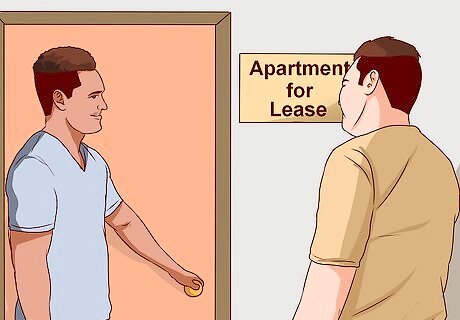
Do a walkthrough with the landlord first. You want to make sure that the building is in good repair, and that the unit itself and its contents aren't damaged or in need of maintenance. If there are any issues, request that the landlord address them before you move in. Check the following: There aren't any holes or cracks in the interior or exterior of the building No window panes are cracked or missing All the locks on the windows and doors are functioning properly The appliances and facilities in the unit are clean and in proper working order. This includes the refrigerator/freezer, stove, toilet, faucets, and lights The walls and ceilings are insulated against weather and noise The elevator works, and there's a service elevator you can use to move in and out There are fire escapes, fire doors, alarms, and smoke detectors
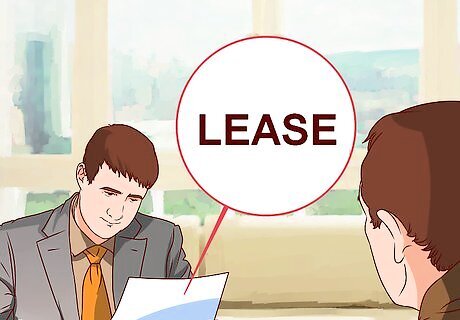
Read through the lease before signing. The lease is important: it’s a legal document, and when you sign it you agree to be bound by its terms. There are lots of things covered by a rental lease, and you want to be familiar with your rights and responsibilities. The lease will tell you: Exactly how much rent you'll pay and what is included The length of the rental term and what happens when it's over (for example, can you renew it?) How much notice you must give before vacating the unit What kinds of repair will be done before you move in and what you're responsible for before you move out The building’s policies on pets, damage, and general conduct Whether you're allowed to sublet the apartment to someone else if you go away for a while How to submit maintenance requests and how long they generally take




















Comments
0 comment